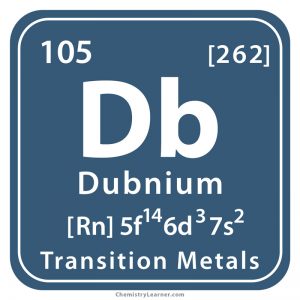Dubnium
What is Dubnium
Dubnium (pronounced as DUB-nee-em) belongs to the family of transition metals and denoted by the chemical symbol Db. It has 12 isotopes out of which the most stable one is dubnium-268 with a half-life of 32 hours [1, 2, 3].
History
Origin of its Name: It is named after Dubna, a town in Russia [1].
Who Discovered it: The name of its original discoverer is still under debate [1].
When and How was Dubnium Discovered
In 1968, Flerov and his team at the Joint Insitute for Nuclear Research (JINR) in Russia produced an isotope of the new element by bombarding americium with neon. Again in 1970, californium was targeted against neon by Ghiorso and his team at the American Lawrence Berkeley Laboratory (LBL) to synthesize isotope-261 of the element. They also challenged the claim of Flerov. While the Russian scientists called it neilsbohrium, the Americans gave the name hahnium.
Finally, it was named dubnium by the International Union of Pure and Applied Chemistry (IUPAC) [1].
Classification and Position of the Element on the Periodic Table [1]
| Group | 5 |
| Period | 7 |
| Block | d |
Properties and Characteristics of Dubnium [1, 2, 3, 6]
General Properties |
||
| Relative atomic mass | 268 | |
| Atomic mass | 268 atomic mass units | |
Physical Properties |
||
| Color/appearance | Unknown | |
| Odor | Unknown | |
| Melting Point/freezing point | Unknown | |
| Boiling point | Unknown | |
| Density | Unknown | |
| State of matter at normal room temperature (Solid/Liquid/Gas) | Solid (not confirmed) | |
| Hardness | Unknown | |
Chemical Properties |
||
| Flammability | Unknown | |
| Oxidation state/Oxidation number | +5 | |
Atomic Data of Dubnium [1, 2, 3]
| Atomic number | 105 |
| Valence electrons | 5 |
| Quantum numbers | Unknown |
| – n | 6 |
| – ℓ | 2 |
| – m ℓ | 0 |
| – m s | +1/2 |
| Electron configuration (noble gas configuration) | [Rn] 5f146d37s2 |
| Atomic structure | |
| – Number of electrons | 105 |
| – Number of neutrons | 163 |
| – Number of protons | 105 |
| Energy levels | |
| – First energy level | 2 |
| – Second energy level | 8 |
| – Third energy level | 18 |
| – Fourth energy level | 32 |
| – Fifth energy level | 32 |
| – Sixth energy level | 11 |
| – Seventh energy level | 2 |
| Radius of atom | |
| – Atomic radius | Unknown |
| – Covalent radius | 1.49 Å |
Uses of Dubnium
As dubnium is neither found free in the environment nor produced in higher amounts at the laboratory, it has no applications other than basic scientific studies [1].
Interesting Facts
- IUPAC had given the temporary name Unnilpentium to dubnium until the dispute regarding its original discovery was resolved [4].
- It is a super-heavy element that might have properties similar to tantalum [5].
Dubnium Cost
The limited production of the radioactive metal in the laboratory does not make it commercially available.
- References
- http://www.rsc.org/periodic-table/element/105/dubnium
- https://education.jlab.org/itselemental/ele105.html
- https://www.chemicool.com/elements/dubnium.html
- http://www.softschools.com/facts/periodic_table/dubnium_facts/707/
- https://www.thoughtco.com/dubnium-element-facts-606525
- http://hobart.k12.in.us/ksms/PeriodicTable/dubnium.htm






